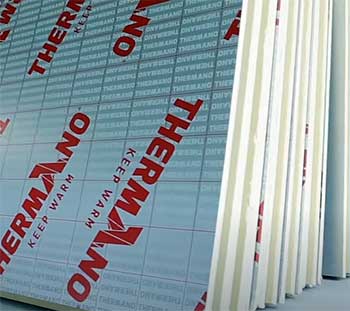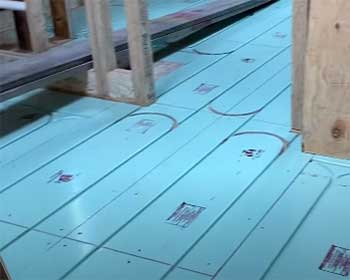Radiant heating is a technique that warms up spaces by heating the floor, which then radiates heat to other objects in the room. It’s a highly efficient heating method that provides consistent temperatures and supreme comfort.
When it comes to radiant heating systems, two names often pop up — Thermal Board and Warmboard. In this article, we’ll delve deep into the world of radiant heating, comparing these two leading brands in terms of their features, pros, cons, and more.
A Brief Comparison Table
| Aspect | Thermal Board | Warmboard |
|---|---|---|
| Material | High-density polystyrene | Conductive aluminum surface over a wooden base |
| Installation | Easier, often DIY-friendly | More complex, usually requires professional installation |
| Heat Output | Adequate but may be less in colder climates or larger spaces | Higher due to superior thermal conductivity |
| Energy Efficiency | Standard | Higher due to faster and more uniform heat distribution |
| Cost | More affordable in terms of both material and installation costs | Higher upfront and installation costs, but can result in long-term savings due to energy efficiency |
| Versatility | Can be installed under any floor covering | Less versatile in terms of floor covering compatibility |
Thermal Board Radiant Heating: An Overview
Thermal Board radiant heating is a lightweight, easy-to-install product that functions as an effective subfloor for all sorts of floor finishes. Made of a high-density polystyrene material, Thermal Boards offer excellent thermal insulation.
Pros of Thermal Board

- Ease of Installation
One of the biggest advantages of Thermal Board is its ease of installation.
It’s lightweight and easy to handle, making it a favorite among DIY enthusiasts.
- Versatility
The Thermal Board can be used under any type of floor covering, from carpet to hardwood, making it a versatile choice for a wide range of applications.
Cons of Thermal Board
- Lower Heat Output
Compared to systems like Warmboard, Thermal Board tends to have a lower heat output. While still effective, it might not provide the same level of warmth in extremely cold climates or large, open spaces.
Warmboard Radiant Heating: Heating Up The Conversation
Warmboard is a radiant heating system that comes in two varieties, Warmboard-R and Warmboard-S. Made of a conductive aluminum surface, these panels offer faster response times and higher heat output than other systems.
Pros of Warmboard
- High Heat Output
Warmboard’s superior thermal conductivity ensures efficient heat transfer, giving you a warm and comfortable space quicker.
- Energy Efficient
Because of its quick response time, Warmboard systems tend to be more energy-efficient, potentially saving you money on utility bills.
Cons of Warmboard
- Installation Complexity
Warmboard installation can be more complex and time-consuming, requiring professional installers.
- Higher Initial Cost
Warmboard comes with a higher price tag, both for the product itself and the installation costs, making it a more significant initial investment.
Key Differences Between Thermal Board And Warmboard Radiant Heating
Understanding the distinctions between Thermal Board and Warmboard is crucial in making an informed decision. Here are the key differences to consider:
- Material Composition

Thermal Board is constructed from high-density polystyrene.
This lightweight and insulating material is great for ease of installation and compatibility with diverse floor coverings.
Warmboard, on the other hand, is made from a highly conductive aluminum surface over a wooden base.
This combination allows for rapid and efficient heat transfer, delivering higher heat outputs than Thermal Board.
- Installation Process
Thermal Board is known for its simplicity when it comes to installation. Its lightweight nature means it’s easy to handle, and it can be installed under any floor covering, offering great versatility.
In contrast, Warmboard installation is more complex. It requires a professional installer due to its weight and the precision required for the system to work efficiently.
- Heat Output and Energy Efficiency
Thermal Board provides a consistent and adequate heat output suitable for many home heating needs. However, it may not perform as effectively in colder climates or larger spaces due to its lower thermal conductivity compared to Warmboard.
Warmboard delivers superior heat output thanks to its aluminum surface. It also warms up faster and more uniformly than Thermal Board. This responsiveness not only contributes to a higher comfort level but also results in more energy efficiency, potentially saving you money in the long run.
- Cost Implications
Thermal Board is generally more affordable, both in terms of material cost and installation. It’s a great option for those working within a tight budget without compromising on quality.
Warmboard, while more expensive upfront and costlier to install, can provide long-term savings due to its superior energy efficiency. It’s an investment that can pay off over time in reduced heating bills.
Remember, while these differences are significant, the best choice depends on the specific needs of your project, your budget, and your long-term goals.
Frequently Asked Questions (FAQ)
Warmboard is a brand of radiant heating systems known for its high heat output and energy efficiency. It comes in two variants: Warmboard-R and Warmboard-S.
Warmboard-R is designed to be installed over an existing subfloor, making it an excellent option for renovations. Warmboard-S, on the other hand, is a structural subfloor and radiant panel in one, making it ideal for new construction.
The maximum surface temperature for Warmboard is 85 degrees Fahrenheit (29.4 degrees Celsius). This temperature ensures optimal comfort without risking damage to the flooring material.
While both have their strengths, Warmboard often comes out ahead in terms of heat output and energy efficiency. That said, Quik Trak may be a more economical choice for those on a tight budget.
Conclusion
In the battle of Thermal Board and Warmboard radiant heating, it’s clear that both have their unique strengths and weaknesses. Your choice between the two will largely depend on your specific needs, budget, and project requirements.
Keep in mind, the best heating system for you is one that effectively warms your space, is within your budget, and aligns with your long-term energy goals.
